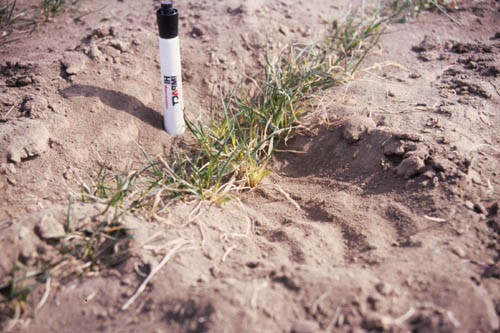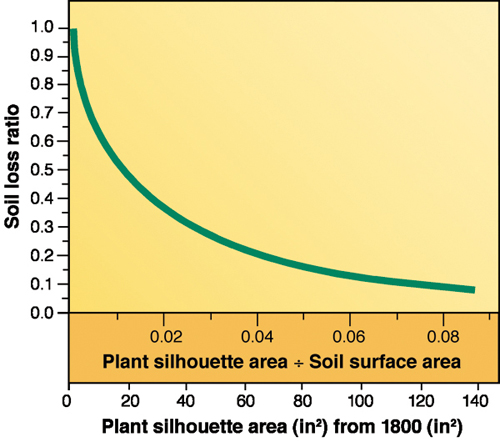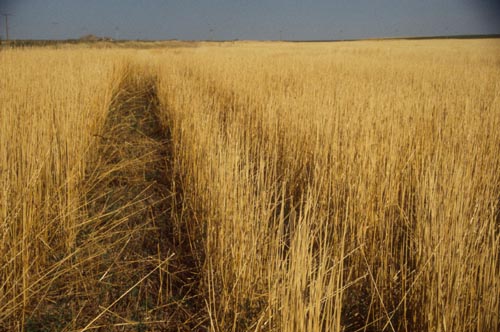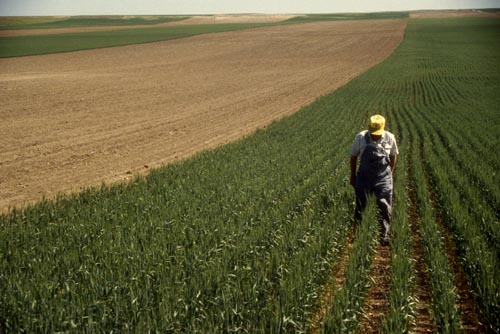G1537
Wind Erosion and Its Control
This NebGuide discusses how wind erosion occurs and presents methods for reducing wind erosion on land devoted to crop production.
Drew J. Lyon, Extension Dryland Crops Specialist
John A. Smith, Extension Machinery Systems Engineer
- Reducing Wind Erosion
- Comparing Crop Residue Effectiveness
- Soil Differences and Field Conditions
- Practical Suggestions for Reducing Wind Erosion
- Acknowledgments
Wind erosion is widespread on agricultural land in the Great Plains, particularly in the semiarid regions. Wind erosion physically removes the most fertile part of the soil (organic matter, clay, and silt) and lowers soil productivity. This loss in productivity increases the costs of producing crops. Blowing soil can reduce seedling survival and growth, depress crop yields, and increase the susceptibility of plants to certain types of stress, including diseases.
Some soil from eroded land enters suspension and becomes part of the atmospheric dust load. Dust obscures visibility and pollutes the air, fills road ditches and impacts water quality, causes automobile accidents, fouls machinery, and imperils animal and human health. Wind erosion is a threat to the sustainability of the land as well as the viability and quality of life for rural and urban communities.
A strong, turbulent wind, coupled with highly erodible field conditions, causes wind erosion. A wind speed as low as 6 mph one foot above the soil surface is capable of starting soil movement under highly erodible field conditions. Erodible field conditions consist of an unprotected soil surface that is smooth, bare, loose, dry, and finely granulated (Figure 1). If a 20 mph wind increases to 30 mph, the rate of erosion will triple. Any erosion control system that increases the minimum wind speed at which soil erosion begins or reduces wind speed at the soil surface will effectively reduce soil erosion.
 |
| Figure 1. Blowing soil fills seed furrows and partially buries small wheat plants in the spring, resulting in increased plant stress that weakens the plants and makes them more susceptible to further damage by disease and other environmental stresses. |
The smallest soil particles, less than 0.004 inch in diameter, are most easily lifted from the soil surface and suspended in the air stream where they may be carried many miles before they fall. Larger soil particles, up to 0.02 inch in diameter, are dislodged and propelled in a bouncing or jumping manner across the soil surface. As they bounce, the force of their impact dislodges other particles from the soil surface and damages or destroys living plants. The bouncing soil particles are responsible for setting in motion other soil particles in an avalanching effect as erosion moves downwind. Still larger particles, 0.02-0.04 inch in diameter, move by rolling on the soil surface.
Reducing Wind Erosion
Many practices can be used to reduce wind erosion, but all are basically directed at accomplishing one or more of the following:
- Reduce wind velocity at the soil surface. This is done with windbreaks, crop residues, cover crops, surface roughness, and stripcropping.
- Trap soil particles. This is accomplished by maintaining crop residues on the soil surface and/or by ridging or roughening the soil surface — all to trap moving soil particles.
- Increase size of soil aggregates. This is done 1) by using crop rotations that include grasses and legumes, 2) by growing high-residue crops and returning crop residues to the soil, 3) by applying manure, and 4) by using emergency tillage, which can create stable clods on the soil surface if soil moisture and texture allow (see NebGuide G2006, Emergency Wind Erosion Control). Increasing the size of aggregates means that it takes a stronger wind to move the soil.
|
||||||||||||||||||||||||||
A protective cover of living vegetation or crop residues on the surface is the simplest and surest way to reduce wind erosion, except during periods of prolonged drought, when it may be difficult to produce and maintain crop residues. Crop residues or growing vegetation reduce wind speed at the soil surface and prevent much of the wind force from contacting soil particles. Vegetative matter on the surface also traps moving soil particles and reduces the avalanching effect. The amount of crop residue required to lessen wind erosion varies with residue type, height, position in relation to wind direction, and soil type.
Conservation tillage reduces wind erosion by leaving crop residues on the soil surface and reducing soil pulverization, which may occur if soils are tilled when dry. Each tillage operation reduces surface residue quantity and dries the soil, making the soil more susceptible to wind erosion. If soil moisture is adequate, tillage may bring erosion-resisting clods to the soil surface, but generally, this is only a short-term solution.
Comparing Crop Residue Effectiveness
The effect of different vegetative covers on wind erosion can be compared by converting to the percent of the soil surface that is covered. Covering 30 percent of the soil surface will reduce soil losses by 70 percent compared to the soil loss for a bare soil (Table I). The percentage of the soil surface covered with crop residues can be visually estimated or measured (see NebGuide G1931, Estimating Percent Residue Cover). The effect of surface cover on soil erosion is the same regardless of residue type.
Standing residues are more effective at slowing wind speed at the soil surface than the same quantity of residue flat on the soil surface. The higher the standing residues are, the more they reduce soil movement by wind. To determine the effect of standing stubble on soil erosion, the height, diameter, and number of stalks in a given area (for example, per square yard) must be estimated. The product of these three values gives the plant silhouette area, which is used in Figure 2 to determine effect on soil erosion. The greater the plant silhouette area, the greater the reduction in wind speed at the soil surface, and consequently the greater the reduction in soil loss. The height is usually determined by the harvesting process, the diameter by the crop type, and the number of stalks by the plant population.
 |
| Figure 2. Relationship between silhouette area and soil loss ratio. The silhouette area is calculated by multiplying stalk height in inches by stalk diameter in inches by the number of stalks per 1,600 square inches (approximately equivalent to 1 square meter or 11.1 square feet) of soil surface area. The smaller the soil loss ratio, the smaller the calculated soil loss will be. |
Table II lists examples of plant silhouette areas for several crops grown under rainfed conditions in western Nebraska. The soil loss ratio given in Table II is a multiplier used in the Revised Wind Erosion Equation to compute soil loss. The smaller the soil loss ratio, the smaller the calculated soil loss will be. For example, if stalk diameter and stalk number per square yard are kept the same, the silhouette area for sunflower can be doubled by cutting sunflower stalks at a height of 24 inches rather than 12 inches (see Table II). The result of the higher cutting height is a soil loss ratio that is half the value of the shorter cutting height, and therefore, one could expect half the soil loss from wind erosion. The examples given in Table II should be used to get a feel for how plant silhouette area is influenced by changes in crop type, cutting height, and stalk density, and not as absolute values representative of a specific crop.
| Table II. Examples of silhouette areas for several dryland crops grown in western Nebraska. | |||||
| Crop | Stalk
height |
Stalk
diameter |
Stalk
no.a |
Silhouette
area |
Soil loss
ratio |
---- inches ---- |
Number/
1,600 in2 |
in2/
1,600 in2 |
|||
| Winter wheat | 10 |
0.12 |
300 |
360 |
0.01 |
| Winter wheat | 10 |
0.12 |
200 |
240 |
0.02 |
| Proso millet | 6 |
0.16 |
100 |
96 |
0.11 |
| Corn | 24 |
0.75 |
3.5 |
63 |
0.19 |
| Sunflower (short) | 12 |
0.85 |
3.7 |
38 |
0.30 |
| Sunflower (tall) | 24 |
0.85 |
3.7 |
75 |
0.15 |
| aNumber of stalks in 1,600 square inches, which is approximately equivalent to 1 square meter or 11.1 square feet. | |||||
The effect of different vegetative covers on wind erosion also may be compared by converting the vegetative covers to a small grain equivalent (SGe), which is a reference condition defined as 10-inch long stalks of small grain parallel to the wind and lying flat in rows spaced 10 inches apart perpendicular to the wind. Several crop residues have been tested in a wind tunnel to determine their SGes, while other values have been determined by regression analyses and estimations. According to charts from the Natural Resources Conservation Service (NRCS), 1,000 lb/ac of flat corn stalks are required to provide as much protection from wind erosion as 200 lb/ac of flat small grain residues. Therefore, 1,000 lb/ac of flat corn stalks has an SGe of 200 lb/ac (Table III). Alternately, 1,000 lb/ac of standing winter wheat stubble, 10 inches high, in 10-inch rows perpendicular to the wind, has an SGe of 3,500 lb/ac. The NRCS may discontinue use of SGe, but currently it is how they link an amount of residue with a corresponding reduction in wind erosion. If SGe use is discontinued, the concepts of ground cover and plant silhouette area will likely replace it.
| Table III. Small grain equivalents (SGe) for 1,000 lb/ac of various vegetative covers.a Amended from 1988 Natural Resources Conservation Service National Agronomy Manual. | |
| Vegetative cover 1,000 lb/ac | Small grain equivalents
lb/ac |
| Standing winter wheat stubble
(10 inches high, in 10-inch rows perpendicular to wind) |
3,500 |
Flat winter wheat stubble |
1,600 |
| Growing small grain, flat surface | 2,000 |
| Flat corn stalks 200 Standing millet stubble | 1,700 |
| Standing grain sorghum residue | 1,300 |
| Flat grain sorghum stalks 350 Standing alfalfa residue, stalks only | 2,900 |
| Dry bean and soybean (random flat residue) | 600 |
| Standing sunflower residue (17 inches high, 30-inch rows perpendicular to wind) |
225 |
| Properly grazed western wheatgrass, 4 inches high | 4,800 |
| aNatural Resources Conservation Service may discontinue use of SGe, but SGe is currently the method used to link the amount of residue with a corresponding reduction in wind erosion. | |
Soil Differences and Field Conditions
A coarse-textured soil requires more crop residues to protect it from wind erosion than a fine-textured soil. Coarse-textured soils may be high in calcium carbonate and low in silt, clay, and organic matter, which results in a high wind erodible fraction, fragile clods, and a low resistance to wind erosion. Stable soil clods help reduce wind erosion. Soil clods formed by tillage should be large enough to resist the erosive force of the wind and protect smaller material. Clod stability depends on soil moisture content at the time the clod is formed, soil density, soil texture, particle size distribution, and microbial activity. Coarse-textured soils such as sandy loams, loamy sands, and sands do not readily form stable clods due to their low clay and organic matter content. These soils need to be moist before tillage to successfully produce even fragile clods. Soils that produce the most stable clods are silt loams, clay loams and silty clay loams. Clods are broken down by raindrop impact, weathering, tillage (especially when soils are dry), equipment traffic, and abrasion by moving soil particles.
A rough surface formed by tillage may be very effective in temporarily reducing wind erosion. Ridges and depressions absorb and deflect part of the wind energy and trap drifting soil particles. Too much surface roughness, however, causes turbulence that may accelerate soil particle movement. Table IV indicates effective ridge heights for various ridge spacings, assuming wind direction is perpendicular to the ridges. Generally, ridges 4 to 8 inches in height are effective in reducing wind erosion across the most commonly used ridge spacings. Remember, however, that the smaller ridges are more quickly destroyed by rainfall.
| Table IV. Effective (√) ridge heights for various ridge spacings, assuming wind direction is perpendicular to the ridges. | ||||||
Ridge height, inches |
Ridge spacing, feet |
|||||
1 |
2 |
3 |
4 |
5 |
6 |
|
2 |
√ |
|||||
4 |
√ |
√ |
√ |
√ |
√ |
|
6 |
√ |
√ |
√ |
√ |
√ |
|
8 |
√ |
√ |
√ |
√ |
||
10 |
√ |
√ |
||||
Practical Suggestions for Reducing Wind Erosion
Keeping a protective cover of vegetative residues or growing crops on the soil surface is the simplest and surest way to reduce both wind and water erosion. To maintain residue cover, many growers have used herbicides to replace one or more tillage operations. The need for tillage is also reduced when straw and chaff are uniformly spread behind the combine. Piles of straw, however, are difficult to plant through and may require extra tillage operations to destroy or spread the crop residues.
Leaving taller residues at harvest is also effective at reducing wind speeds near the soil surface and reducing soil erosion. In small grains, a stripper header can be used to leave a taller stubble that does an excellent job of trapping snow for additional soil water recharge as well as reducing soil loss from wind erosion; however, when using a stripper header, be sure to select small grain varieties with strong straw or much of the residue may fall over with the first wet snowfall (Figure 3).
 |
| Figure 3. This wheat field south of Sidney, Neb., was harvested with a Shelborne Reynolds Combine Stripper Header. The use of a stripper header for wheat harvest can leave a tall wheat stubble that provides excellent protection against wind erosion. Additionally, a taller stubble has been found to decrease soil water loss through evaporation, reduce weed infestations, and catch and retain more wind-driven snow in fields where the extra moisture can significantly increase the yield of the following crop. |
Another means of increasing silhouette area is to increase the number of stalks in a given area. Be careful not to increase plant density too much or crop performance may suffer. For example, planting rainfed sunflower at too high a population for a given site may result in weakened stalks that break more easily, resulting in a shorter stalk height and reduced silhouette area. Despite their smaller stalk diameter, small grains usually do a better job of reducing wind erosion than crops like corn or sunflower because they have many more stalks per given area (Table II).
Irrigated crops like sugarbeet and dry bean leave little residue cover. A cover crop such as winter wheat or winter rye may be planted after dry bean to provide soil cover, but the crop must be planted early enough (by mid-September) to allow sufficient establishment of the cover crop to prevent soil blowing during the winter and early spring. To increase the odds of success with a fall cover crop, growers may want to consider planting a short season dry bean variety in late May to help assure an early harvest. Irrigation before planting the cover crop should be considered if soil conditions are extremely dry in order to ensure consistent and uniform seeding depth and rapid crop emergence. The cover crop rows should be planted perpendicular to the prevailing wind direction, which is usually from the northwest. If using a disk drill, row spacings should be narrow (6 to 8 inches). Wider row spacings are acceptable if a hoe drill is used and ridges are formed. If crops are harvested too late in the season to allow for adequate establishment of a cover crop, producers should consider increasing surface roughness with tillage or by applying manure or crop residues.
Stripcropping can help control soil erosion by reducing soil avalanching (Figure 4). The rate of soil avalanching varies directly with the erodibility of the soil and the width of the eroding field. Soil type is one factor that determines the width of strips. Strips should be arranged perpendicular to the prevailing wind direction. Visit your local USDA-NRCS office for specific information on using stripcropping on your farm.
 |
| Figure 4. Stripcropping is a common practice in the Nebraska Panhandle to reduce wind erosion and winter-kill problems. Soil type is one factor that determines the width of the strips. Strips should be arranged perpendicular to the prevailing wind direction. |
Acknowledgments
The authors acknowledge the contributions made to this publication by Dr. Donald W. Fryrear, former USDA-ARS scientist, Big Spring, Tex. Dr. Fryrear spent many years studying wind erosion in the Great Plains and supplied much of the information on silhouette area used in this publication.
An earlier version of this material was published in Conservation Tillage Systems and Management, Second Edition, MidWest Plan Service, Ames, Iowa; 2000. This is used with permission. This publication has been peer reviewed.
This publication has been peer reviewed.
Visit the University of Nebraska–Lincoln Extension Publications Web site for more publications.
Index: Soil Management
Conservation
2004, Revised March 2010